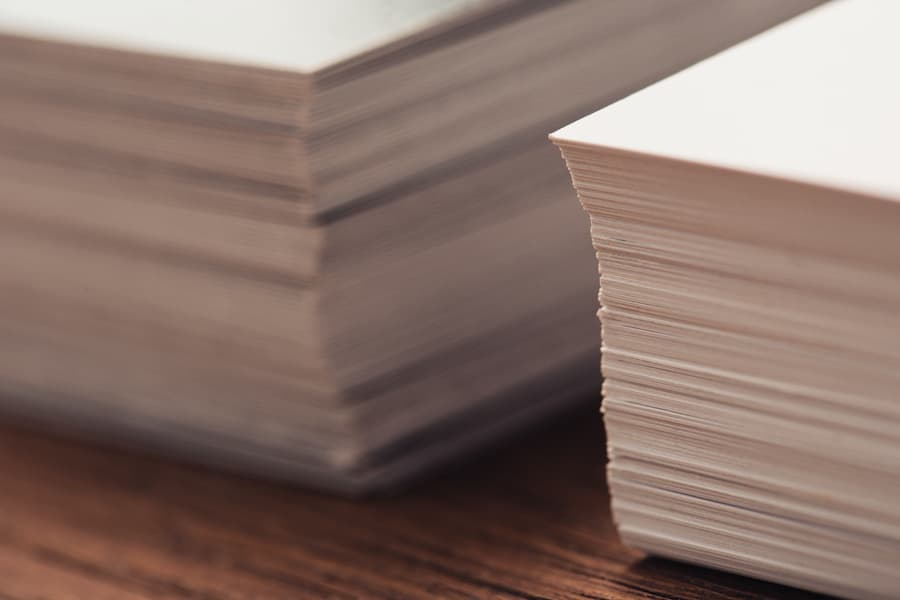Comparing Copy and Printer Paper: What’s Different
Copy Paper vs Printer Paper
When it comes to choosing the right type of paper for your printer, understanding the difference between copy paper and printer paper is essential. Both serve distinct purposes and come with their unique features, making it crucial to use the right paper for your printing needs. Copy paper is thinner and cheaper, making it an affordable option for everyday use. On the other hand, printer paper is thicker and is designed for use in printers, especially those that handle printing documents with images.
The right paper can make a significant difference in the quality of your printed text and images. Understanding the difference between printer paper and copy paper is crucial if you want to print documents with vibrant colors and sharp text. Whether you need to print everyday documents or high-quality images, choosing the right paper for your printer can ensure that your printing needs are met effectively.
In this article, we’ll delve into the various types of printer paper and copy paper, their features, and the best use for each type. By the end, you’ll have a better understanding of which paper to use for specific purposes and how to avoid paper jams by using the wrong type of paper.

What Is Copy Paper?
Transitioning from the previous section, it’s important to understand that while standard copy paper is an affordable and versatile option, it may not be the best choice for all printing needs. When it comes to printing images, glossy paper is generally the preferred option due to its ability to showcase vibrant colors and sharp details. Unlike standard copy paper, glossy paper is coated to ensure that the ink doesn’t spread and saturate the paper, resulting in a high-quality image.
On the other hand, when it comes to printing text documents or rough copies where high quality is not a priority, standard copy paper is the go-to choice. Its thinner and more affordable nature makes it suitable for everyday office use, handling large volumes of text documents with ease. It’s also worth mentioning that while standard copy paper may not be the best for printing images, it is the right choice for multipurpose use, making it a staple in most office settings.
Understanding the limitations of standard copy paper when it comes to printing images, it’s important to choose the right paper for specific purposes. Whether it’s for text documents, rough copies, or high-quality image printing, there are different types of paper designed to meet these needs. By understanding the characteristics and features of each paper option, you can ensure that your printing needs are met with the best possible results.
What Is Printer Paper?
Transitioning from copy paper to printer paper, it’s essential to understand the distinction. Printer paper is a higher-quality, thicker paper that is generally more expensive. This paper is best for reproducing images without saturation and with better light passage. When you want to print high-quality images or text, using the right printer paper is crucial for achieving the best results.
Printer paper typically has a higher paper weight and is usually thicker than regular paper. This thickness allows for better ink absorption and prevents the ink from bleeding, making it ideal for printing vibrant images and crisp text. Additionally, the paper brightness and coating make it an ideal choice for producing high-quality prints, especially when using inkjet and laser printers.
In comparison to multipurpose paper, printer paper features a smoother texture and is usually designed for printing high-resolution images. The paper is typically used for specific purposes, such as printing photographs, brochures, presentations, and other materials that require sharp, vivid details. While it may be more expensive than regular office paper, the quality and effectiveness of printer paper make it an affordable option for achieving professional-grade prints.
Key Differences Between Copy Paper and Printer Paper
When it comes to paper for printing, there are key differences that make each type unique. One of the most noticeable differences is the thickness and quality of the paper. Printer paper is typically thicker and of higher quality compared to copy paper. This allows it to hold up better when printing documents with images or requiring higher quality. On the other hand, copy paper is thinner and more affordable, making it ideal for everyday printing needs.
Another key difference is the weight of the paper. Printer paper is usually around 24 pounds, providing a sturdier feel compared to the lighter 20-pound copy paper. This weight difference can also affect how the paper passes through the printer, especially if you’re using an inkjet printer or laser printer.

In terms of price, printer paper is generally more expensive than copy paper due to its higher quality and thickness. While copy paper is an affordable option for everyday use, printer paper is worth the investment when you need to print documents with a professional look and feel.
Overall, understanding the differences between these two types of paper can help you choose the right paper for your specific printing needs. Whether it’s for printing text, images, or a combination of both, using the right paper can make a significant difference in the quality of your printed documents.
Other Types of Paper to Consider
Looking to add a touch of elegance to your written correspondence or printed materials? Consider linen paper. With its unique texture and subtle cross-hatch pattern, linen paper is perfect for notepads, fancy letterheads, and menus. The raised lines and texture of linen paper give it a sophisticated and professional look, making it an excellent choice for formal printed materials.
In addition to linen paper, there are other specialized papers worth considering for specific printing needs. For instance, photo paper is glossy and is usually used for printing high-quality photographs. Cardstock is a common type of heavyweight paper, thicker than regular printer paper and often used for printing invitations, greeting cards, and business cards. Coated paper is another type of paper used to print vibrant and sharp images, making it suitable for brochures, flyers, and marketing materials.
When it comes to everyday printing needs, bond paper is a versatile option that can be used in a variety of printers. It’s thinner than printer paper and is commonly used for text-heavy documents and reports. Laser paper, on the other hand, is designed for use in laser printers and is known for its smooth finish and durability as it passes through the printer without causing jams.
Each of these specialized papers has its own unique characteristics and uses, so it’s important to choose the right paper for your specific printing needs.
Importance of Choosing the Right Paper
When considering the myriad of paper options available, it’s crucial to understand the impact of choosing the right paper. Using the wrong paper can lead to a variety of issues that affect the overall quality of your prints. For example, if the paper is too thin, it may result in reduced print quality, causing ink to bleed through or images to appear faded. On the other hand, using paper that is too thick can increase the risk of paper jams and potentially damage your printer.

The correct paper choice can save time, money, and ensure high-quality prints. By selecting the appropriate paper, you can avoid the hassle of dealing with paper jams, which can be a significant time waster. Additionally, using the right paper can help prevent damage to your printer, saving you from costly repairs or replacements. Furthermore, the right paper can enhance the overall appearance of your prints, ensuring that text and images are sharp and vibrant.
When choosing paper, it’s essential to consider the thickness of the paper and other types of printing paper, as well as the printer’s specifications. Understanding how different paper options interact with your printer can help you make informed decisions and ensure optimal printing results. By taking the time to measure and compare paper options, you can ensure that the paper you’re using is ideal for your specific printing needs.
What People Also Ask
Is copy paper the same as printer paper?
Copy paper and printer paper are not the same. Copy paper is generally thinner and less expensive, making it ideal for everyday text document printing where high quality is not a priority. Printer paper, on the other hand, is thicker and of higher quality, which makes it more suitable for printing images or high-quality documents. It is usually more expensive than copy paper.
Can you use copy paper in a printer?
Yes, you can use copy paper in both inkjet and laser printers without any issues. However, due to its thinness, the quality of the print may not be as good as with printer paper. It is suitable for basic printing needs but may not provide the best results for high-quality images or documents.
Can you use any paper as printer paper?
Technically, both inkjet and laser printers can print on various types of paper. However, the quality of the final print significantly depends on the paper type. Specialized printer papers are designed to optimize print quality, with properties like specific coatings, weights, and brightness levels. Using the appropriate paper for your printing task is crucial to achieve the desired quality and to prevent issues like paper jams or ink smudging.
Which paper is used to copy?
Copy paper is specifically used for photocopying and general printing. It is a thin grade of paper, usually quite affordable, and is best for simple text documents and rough copies that do not require high quality. Its properties make it less ideal for printing images, as they may appear saturated due to the paper’s thinness.
Conclusion
In conclusion, understanding the differences between copy paper and printer paper is essential for ensuring the best results when printing. By knowing the key distinctions and considering other types of paper available, you can make an informed decision about which paper to use for your specific needs. It’s important to choose the right paper for your printer, considering factors such as the type of text and images you plan to print, as well as the features your printer can handle.
By taking the time to measure paper and consider printing paper types and sizes, you can avoid issues such as paper jams and ensure that your documents and images come out crisp and clear every time. Remember that the paper you’re using can have a significant impact on the outcome of your printed materials, so it’s worth investing in the right printer paper for the best results.
For more information and services you can contact us for a free quote and estimation.
- Address: 165 Veterans Way, Warminster, PA 18974
- Email: sales@aispa.us
- Call Us: (215) 999-8445










